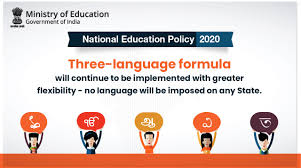The Three-Language Formula in India’s National Education Policy (NEP) 2020: Promoting Multilingualism and Unity

India, a land of diverse languages, cultures, and traditions, has always celebrated its linguistic richness. The National Education Policy (NEP) 2020, introduced by the Indian government, aims to harness this diversity by emphasizing multilingualism and promoting national unity. One of the key features of the NEP is the three-language formula, which has sparked discussions and debates across the country.
Understanding the Three-Language Formula
The three-language formula encourages students to learn three languages during their educational journey. Let’s delve into the details:
- Two Native Indian Languages: The NEP mandates that students learn two native Indian languages apart from their mother tongue. These languages could be regional languages or languages spoken widely across the country. The goal is to foster a deeper understanding of India’s linguistic heritage and promote cultural exchange.
- English as the Third Language: The third language in the formula is English. English has long been associated with upward mobility, global communication, and access to knowledge. By including English as a mandatory language, the NEP aims to equip students with the skills needed to thrive in an interconnected world.
Autonomy and Language Choice
The NEP recognizes the diversity of India’s states and respects their autonomy. States have the freedom to choose the two native Indian languages they want to include in their curriculum. This flexibility prevents language imposition and ensures that linguistic preferences are respected.
Similarly, students have the liberty to select their languages. They can choose their mother tongue, regional languages, or other languages they find interesting. Additionally, students have the option to change one of their chosen languages in Grades 6 or 7, allowing for adaptability.
Medium of Instruction
The NEP places significant emphasis on the medium of instruction. It recommends using the local or regional language (often referred to as the mother tongue) as the medium of instruction until at least Grade 5. Ideally, this practice should continue up to Grade 8 or beyond. Here are the reasons behind this recommendation:
- Cognitive Development: Research suggests that children learn best when taught in their mother tongue. It enhances cognitive development, comprehension, and critical thinking.
- Preserving Cultural Identity: Learning in one’s mother tongue fosters a sense of identity and pride. It connects students to their cultural roots and heritage.
- Smooth Transition: Starting education in the mother tongue provides a strong foundation. Later, transitioning to other languages becomes smoother.
Challenges and Implementation
While the NEP’s vision is commendable, there are challenges to its successful implementation:
- Early Language Pressure: Introducing three languages early can be overwhelming for young learners. Balancing proficiency in multiple languages requires effective teaching methods and resources.
- Teacher Shortage: Qualified language teachers are essential for effective language education. The NEP acknowledges this gap and aims to address it through teacher training programs.
- Digital Resources: Leveraging digital platforms can enhance language learning. The NEP encourages the creation of high-quality digital content in various languages.
In conclusion, the three-language formula in India’s NEP 2020 is a step toward celebrating linguistic diversity while fostering national unity. By nurturing multilingualism, India prepares its students for a globalized world while preserving its rich cultural tapestry.
- Log in to post comments
